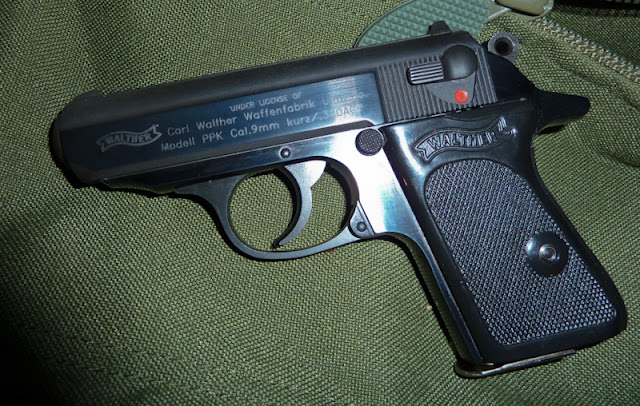As any real James Bond fan knows, this is the gun that Q equipped 007 with after he was forced to give up his mouse pistol- a Beretta .25. This wasn't much of a step up, by modern standards; the .25 ACP develops around 65 foot-pounds of muzzle energy, and the .32ACP used by the original PPK comes in at 123 foot-pounds. Yes, it's twice as much as the .25ACP, but the .380 ACP, which this gun is chambered for, develops around 200 foot-pounds of ME, or almost twice as much again.
I admit that the Bond connection did play some role in my selection of this pistol, but my main reasons for choosing it had more to do with reliability, accuracy and safety. I was looking for a replacement for the S&W 442 that was more accurate, easier to control, and if possible, just as reliable. I was also looking for a gun with a safety- the gun should be difficult or impossible to fire if it's picked up by the wrong person, whether it's someone trying to do you harm, or a careless child or adult. Yes, there are people who on picking up a gun will pull the trigger to see if it's loaded, as I noted in a previous entry.
I chose .380 as it develops as much ME as does a .38Spl in a snub nosed barrel, and there are a lot of .380 guns to choose from these days. Most of them are double action only (DAO) though, and almost none have a safety. I wanted a gun with double action, so it didn't have to be carried cocked and locked (should I decide to carry it), and one with a positive safety, for reasons already mentioned. That still left a few guns, but I also limited myself to the top quality makes. Saving a few hundred dollars on the purchase of a gun doesn't mean much when it misfires at an inopportune time.
I looked at two from SiGARMS, the P238 and the P232. The P238 is a downsized Colt 1911, and while it's a very high quality gun, it's single action, which means, like the 1911, it has to be carried either cocked and locked, or with an empty chamber. The P232 is a modern double action guns, with a de-cocking lever, but no safety. Uncocked, with a round in the chamber, it only takes a pull of the trigger to fire.
That left the PPK. Interestingly enough, the PPK- or rather, the PP, which preceded it- is really the father of almost all modern double action autos, dating back to 1929. Every double action gun since then owes a debt to the Walther. What particularly appeals to me is the integrated safety/decocking lever. Put the safety on, and rack the slide. It'll load a round, and then drop the hammer on a hammer block. Pull the trigger, and nothing happens. Flick the safety off, and now when you pull the trigger it'll fire. This is second nature with a little practice, but should slow up someone not familiar with the gun. Once fired, it will continue to cycle and fire in single action mode. Flip the safety/decocking lever, the hammer drops on the hammer block, the trigger is locked, and it's in safe mode again.
Importation of the PPK was banned by the 1964 GCA as it was just a little too small to meet the (arbitrary) standards set by that law. Walther responded by creating the PPK/S, which combined the shorter barrel and slide of the PPK with the longer grip of the original PP. Today, all PPKs and PPK/Ss are made in the US by S&W, under license from Walther, so the size is a non-issue. The PPK/S is the more popular model, probably because it fills the hand a bit better, and you can find more accessories, like aftermarket grips, for it. (Or maybe you can find more accessories because it's more popular)
Another nice feature of the PPK is the fixed barrel, a consequence of the straight blowback design. While this doesn't absorb recoil energy as well as the delayed blowback design used by most modern autos, it is somewhat more accurate. Not that you're going to be shooting bullseye competitions with a PPK, but 4" groups at 25 yards are better than 8" groups.
Having been designed for the .32ACP, the PPK in .380 does bite a bit, and as noted, no one's making rubber aftermarket grips for it,. There's a simple enough solution, though. Cut a 3" section of bicycle tire innertube and slip it over the plastic grips. That will provide a non-slip grip while still protecting your skin from the serrated teeth on the hard plastic grip. (I later replaced the plastic panels with a great looking set of walnut panels from Altamont.)
If you find yourself shopping for a PPK or PPK/S, be advised that some of the early models made by S&W suffered from a very serious defect- engaging the decocking lever could result in the gun firing! Check any used S&W PPK or PPK/S against the serial numbers at Smith & Wesson's web site. If the gun in question falls into that range of numbers, look for a center punch mark on the frame behind that hammer- that's how S&W marks guns returned to the factory for modification.
Update: I eventually sold the PPK, as it was very unpleasant to shoot. I replaced it with a Ruger LCP that is smaller, lighter, and much more comfortable to shoot.


No comments:
Post a Comment